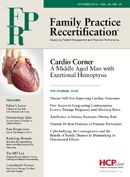Niacin: Still Not Improving Cardiac Outcomes
A closer look at the usage of niacin for patients with vascular disease

Frank J. Domino, MD
Review
Effects of Extended-Release Niacin with Laropiprant in High-Risk Patients; The HPS2-THRIVE Collaborative Group; N Engl J Med 2014; 371 )3):203-12. DOI: 10.1056/NEJMoa1300955
This large randomized controlled trial found adding niacin to treatment of patients with known vascular disease lowered LDL and raised HDL, but did not impact the rate of major vascular events, and did cause harm.
Study Methods
This was a randomized, controlled trial of 25,673 adults with known vascular disease (men and women 50 - 80 years; with history of myocardial infarction, cerebrovascular disease, peripheral arterial disease, or diabetes mellitus with evidence of symptomatic coronary disease) to compare 2g of extended-release niacin combined with 40 mg of laropiprant or a placebo daily for just under 4 years. (Laropiprant has no impact on cholesterol, but reduces the flushing reaction associated with niacin.)
After a run-in phase to standardize the statin therapy and to establish participants’ ability to tolerate extended release niacin without clinically significant adverse effects, patients were randomized to intervention and placebo and followed for vascular outcomes (first major vascular event: nonfatal myocardial infarction, death from coronary causes, stroke, or arterial revascularization), and for adverse events.
Results and Outcomes
After a median follow up for 3.9 years, the intervention group had a 10 mg/dL decrease in LDL cholesterol and a 6 mg/dL increase in HDL cholesterol. Nonetheless, there was no difference in vascular event outcomes in either group (13.2% intervention vs. 13.7% placebo; RR = 0.96; 95% CI 0.90 — 1.03; p = 0.29).
Adverse events were higher in the intervention group. 33% of those in the intervention arm had to withdraw from the study due to adverse events. The intervention group had a significant increase in risk of fatal or nonfatal serious adverse events (55.6% vs. 52.7%, P<0.001). These included increases in “serious” disturbances in diabetes control, and an increased rate of new diabetes diagnosis (1.3% greater in the intervention vs. placebo.) Other side effects more common in the intervention group included “serious” GI disturbances, muscle-skeletal issues (including myopathy), infection rates and bleeding excess.
Outcomes
In patients with known vascular disease, use of niacin + laropiprant led to an improved lipid profile, but worse vascular event rate, as well as a higher rate of serious adverse events.
Commentary
Altering numbers is not the same as improving disease. This study demonstrates that by changing disease oriented outcomes (i.e the surrogate markers of lowering LDL and raising HDL) by any means does not always produce improved patient outcomes. Using logic (niacin raised HDL) in medicine has lead to many failures, and much morbidity and mortality. To prove a benefit, interventions should be tested by randomized, controlled trials which look at patient-oriented outcomes.
From previous statin based meta-analysis, a 10 mg/dL reduction of LDL cholesterol level should correlate with a 5 to 6% reduction in the risk of major vascular events. From other established data, an increase of 6% in HDL cholesterol through lifestyle modification and exercise should result in a 4% - 5% reduction in vascular events. There was no reduction in vascular outcomes here.
This study demonstrates a recurring theme in modern medicine. Logical assumptions about an intervention do not always correlate with the logically concluded outcomes. We have known for years that populations whose diets were rich in protein from fish sources had lower rates of cardiovascular disease. From this, fish oil capsules began to be recommended, thinking it was to the Omega 3 from fish oil that led to improved cardiac outcomes. Unfortunately, it was eating fish, not fish oil capsules that made you healthier. Likewise, raising HDL cholesterol through exercise lowers cardiovascular risk. Drug induced increases in HDL does not.
About the Author
Frank J. Domino, MD, is Professor and Pre-Doctoral Education Director for the Department of Family Medicine and Community Health at the University of Massachusetts Medical School in Worcester, MA. Domino is Editor-in-Chief of the 5-Minute Clinical Consult series (Lippincott Williams & Wilkins).
Additionally, he is Co-Author and Editor of the Epocrates LAB database, and author and editor to the MedPearls smartphone app. He presents nationally for the American Academy of Family Medicine and serves as the Family Physician Representative to the Harvard Medical School’s Continuing Education Committee.
